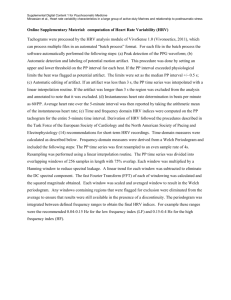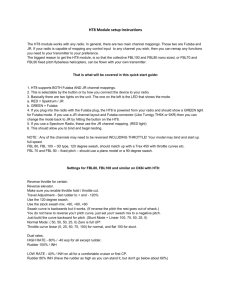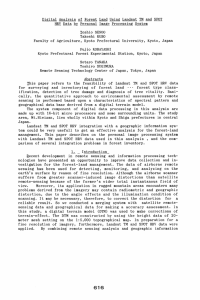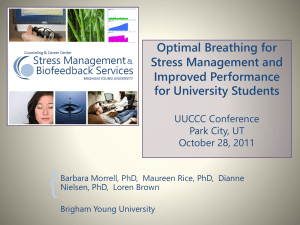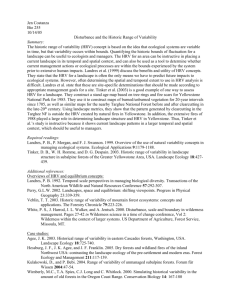COMPARATIVE ANALYSIS OF LANDSAT-5 TM ... KANAZAWA REGION S.Ueno*, Y.Kawata, and T.Kusaka
advertisement
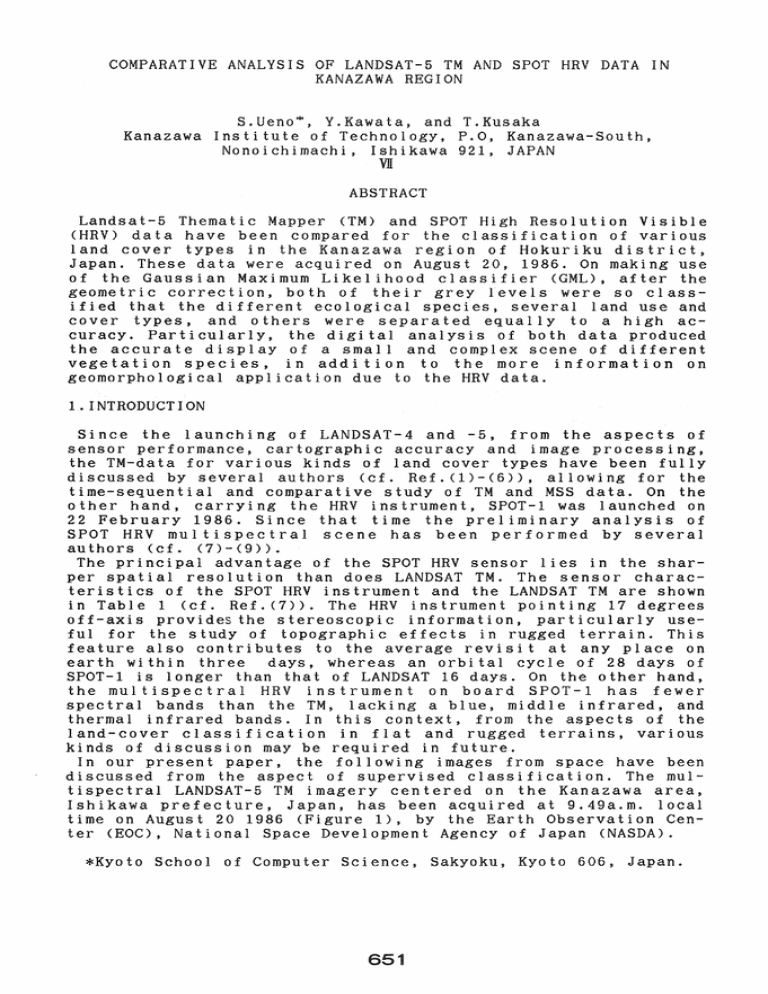
COMPARATIVE ANALYSIS OF LANDSAT-5 TM AND SPOT HRV DATA IN KANAZAWA REGION S.Ueno*, Y.Kawata, and T.Kusaka Kanazawa Institute of Technology, P.O, Kanazawa-South, Nonoichimachi, Ishikawa 921, JAPAN Vll ABSTRACT Landsat-5 Thematic Mapper (TM) and SPOT High Resolution Visible (HRV) data have been compared for the classification of various land cover types in the Kanazawa region of Hokuriku district, Japan. These data were acquired on August 20, 1986. On making use of the Gaussian Maximum Likelihood classifier (GML), after the geometric correction, both of their grey levels were so classified that the different ecological species, several land use and cover types, and others were separated equally to a high accuracy. Particularly, the digital analysis of both data produced the accurate display of a small and complex scene of different vegetation species t in addition to the more information on geomorphological application due to the HRV data. 1. INTRODUCTION Since the launching of LANDSAT-4 and -5, from the aspects of sensor performance~ cartographic accuracy and image processing, the TM-data for various kinds of land cover types have been fully discussed by several authors (cf. Ref.(I)-(6», allowing for the time-sequential and comparative study of TM and MSS data. On the other hand, carrying the HRV instrument, SPOT-l was launched on 22 February 1986. Since that time the preliminary analysis of SPOT HRV multispectral scene has been performed by several authors (cf. (7)-(9». The principal advantage of the SPOT HRV sensor lies in the sharper spatial resolution than does LANDSAT TM. The sensor characteristics of the SPOT HRV instrument and the LANDSAT TM are shown in Table 1 (cf. Ref.(7». The HRV instrument pointing 17 degrees off-axis provides the stereoscopic information, particularly useful for the study of topographic effects in rugged terrain. This feature also contributes to the average revisit at any place on earth within three days, whereas an orbital cycle of 28 days of SPOT-l is longer than that of LANDSAT 16 days. On the other hand, the multispectral HRV instrument on board SPOT-l has fewer spectral bands than the TM, lacking a blue, middle infrared, and thermal infrared bands. In this context, from the aspects of the land-cover classification in flat and rugged terrains, various kinds of discussion may be required in future. In our present paper, the following images from space have been discussed from the aspect of supervised classification. The multispectral LANDSAT-5 TM imagery centered on the Kanazawa area, Ishikawa prefecture, Japan, has been acquired at 9.49a.m. local time on August 20 1986 (Figure 1), by the Earth Observation Center (EOC) , National Space Development Agency of Japan (NASDA). *Kyoto School of Computer SCience, Sakyoku, Kyoto 606, Japan. 651 Then, the mul tispectral SPOT-1 HRV imagery covering the above area has been also acquired at 10.S0a.m. local time on August 20 1986 (Figure 2) by SPOT Image. After the radiometric and geometric corrections, with the aid of the supervised classification, we have done the preliminary comparison of the TM and HRV imagery acquired successively at the same date, allowing for the fine structure of the imagery. In our further works, the unsupervised classification, texture analysis, and the spectral statistics wi II be taken into account for the comparative study of the TM and SPOT imagery. 2.PREPROCESSING 2.1 PreliminarY data handling 2.1.1 Data acquisition The Landsat-S TM data in digital format handled by us have been acquired by the Earth Observation Center (EOS), National Space Development Agency of Japan (NASDA), and then have been preprocessed in terms of the systematic radiometric and geometric correction by EOS. On the other hand, the SPOT-I HRV data handled by us have been acquired by the SPOT Image and then have been calibrated radiometrically and geometrically in a manner similar to the TM data. According to the annotation records, the handling data of both Computer Compatible Tape (CCT) are listed in Table 2. Both TM and HRV data under consideration covered the land-use map (1:2S,000) of such areas as "Kanai watt, "Awagasaki", ttMatsuto", and "Kanazawa", in Ishikawa prefecture, Japan. 2.1.2 Data processing Ground cover conditions in the above areas were identified by a jOint work of Geographical Survey Institute (GSI) and Ishikawa Research Laboratory for Public Health and Environment (IRLPHE), with the aid of the land-use maps, aerial photographs, and meteorological data. The total number of pixels in ground truth data is several thousands in our study (test) site. The cartographic accuracy was shown to be within twenty five meters in land-use map. Based on the available ground truth data and aerial photographs on the study site, the TM data in unit of thirty meters span under consideration was extracted from the subscene CCT data. In other words, a 800x800 pixel block area was drawn out from the subscene of CCT-PT. In a manner similar to the above case, a 800x800 pixel block area in unit of twenty meters span was drawn out from the SPOT HRV. 2.2 Geometric correction The study and test sites are almost centered in Ishikawa prefecture and is covered by Landsat-S subscene whose path-row is given in Table 2. This region is characterized by a blend of aqueous, urban, rural, and eco I ogi calland-cover fea tures assoc i a ted wi th rugged terrain relief up to several hundred meters high. In order to implement the geometric correction, an almost uniform network of Ground Control Points (GCP) was identified on both the Landsat-S TM and SPOT-I HRV image data and the 1:2S,000 scale land-use map covering the study (test) area. In our case we used a pair of global bivariate quadratic polynomial functions. It is of interest to mention that the residuals 652 of 16 GCP's were found less than one pixel size. Furthermore, the resampling procedure, i.e., the determination of the radiance value to be assigned to each output pixel, was performed via the Nearest Neighborhood Method (NNM). The reason why we referred to this NNM is due to the fact that our CCT data have suffered the resampling based on the cubic convolution by NASDA. In a manner similar to the TM imagery, the geometric correction of SPOT HRV data has been performed. Whereas the spatial resolution of TM and multispectral HRV data are respectively thirty and twenty meters, however, the pixel size of both images is identified with that of the ground truth map prepared by GSI and IRLPHE, i. e., twenty five meters square. The reason why such a modification has been done is to make easy the supervised classification of both imagery compared with the ground truth data prepared by GSI-IRLPHE in pixel size of twenty-five meters. 3. CLASSIFICATION The legend of the aqueous, urban, rural, ecological, and other cover types adopted by GSI is listed in Table 3. The total number of the ground truth area is about three hundreds, in each of which the number of samples was a few tens. The ground truth site not used for the supervised classification was used as a test site for the verification of the classification accuracy. The Gaussian Maximum Likelihood (GML) claSSifier has been used for the supervised classification. Data processing: On making use of the available ground truth data and aerial photographs, the 800x800 TM and HRV pixel area were extracted from the subscene TM data and full scene SPOT data, respectively, and were corrected geometrically. There is a wide range of land use and cover types on the study (and test) site under conSideration. The major cover types in the study site are water, forest, agriculture, transportation, routes, commerCial, industrial, and residential area. The legend of land cover types adopted for the classification of TM and HRV data is listed in Table 4. In order to keep the classification accuracy, around a few tens of sample pixels for each of the classes under consideration were extracted from the TM data in study site. For the color image presentation the overall TM bands except for the 6th band were adopted, whereas in the case of HRV data the bands 1,2, and 3 were together used by the GML classifier. 3.1 Supervised classification On making use of the GML classifier, we classified the grey levels in TM and HRV data on August 20, 1986. The results in percent of the above classification are listed in Table 5 through 8, respectively. The claSSification accuracy is defined as the ratio of the number of pixels identified as the class under consideration over the overall total number of pixels in the study (or test) site. In these tables the total numbers of pixels used for the ground truth data are listed. 3.2 Comparison of TM and HRV imagery It has been pointed out by a few authors (cf. Ref.(7» that there were only minor differences in spectral response between TM 653 and HRV bands for a comparable environment in Chott et Djerid scene. However, it seems that, with respect to the geomorphological aspects, the improved spatial resolution has given more reliable information on the detailed pattern of fields in flat terrain. In our present paper, based on the supervised classification results in Tables 5 through 13, it is shown that LANDSAT-5 TM and SPOT-l HRV identify almost similarly the detailed ground feature categories. In other words, the digital analysis of both above data produced the accurately classified display of a small, complex scene of an area under consideration. Whereas the spatial resolution of TM data is low compared with that of HRV, the many wavelength combinations gave rise to the high resolution monitoring of urban area, field and others. On the other hand,itseems that the HRV data are useful for acquiring information of spatially complex ground features and ecological analysis. In order to do readily the comparative study of TM and HRV data, in Tables 12 and 13 we showed the classification results of TM and HRV data in five comprehensive categories. In the study site the mean classification accuracy in percent of TM and HRV data into five comprehensive categories are 91.9%and 78.2%, respectively. On the other hand, in the case of the test site the mean classification accuracy in percent of TM and HRV data into five categories are 78.2% and 76.2%, respectively. It seems that, whereas in the study site there may be some difference of the mean classification accuracy between TM and HRV data, in the test site it reduces to the negligible difference. Such a tendency is also shown in the mean classification accuracy in percent of TM and HRV data into 13(or 15) categories. It seems to be due to the fact that the spatial high resolution of HRV instrument in study site consisting of small number of ground-truth data gives rise to especially the large dispersion of the statistical quantities in other area, i.e., the fields. and meadow, consisting of non-unoform miscellaneous ground patterns. However, from the aspect of the classification accuracy in percent of the TM and HRV data in test site, both data have almost comparable high reliability. On the other hand, from the geomorphological aspect, the HRV data are superior to the TM data, particularly in the area consisting of the complex patterns, e.g., the residential region, the ridge between fields and others. 4. DISCUSSION The classification accuracy of Landsat TM data is so high even as compared with that of SPOT HRV data. Whereas the instantaneous field-of-view for HRV data is much higher than that of TM data, the classification accuracy of HRV data seems to be of the same order of magnitude as compared with that of TM data. It may be due to the fact that the total number of spectral bands useful for the supervised classification for TM data exceeded that of the SPOT HRV data. On the other hand, HRV imagery is much superior geomorphologically to the TM imagery. Finally, in Figure 1 and 2 are shown the TM and HRV images in full scene classified in Tables 6 and 8. For our comparative study of the supervised classification accuracy of TM and HRV data, it requires to prepare the HRV imagery in unit pixel size of twenty meters span. Furthermore, the clustering, texture and multi temporal analysis of these data for the land cover classification will be performed later on. REFERENCES 1. R.Bernstein, J.B.Lotspiech., H.J.Meyers, H.G.Kolsky, and R.D.Lees. 1984. "Analysis and processing of Landsat-4 senser data using advanced image processing techniques and technologies", IEEE Transaction on Geoscience and Remote Sensing", Vol. GE-22, pp.192-221. 2. P.E.Anuta, L.A.Bartolucci, M.E.Dean, D.F.Lozano, E.Malarlet, C.D.McGillem, J.A. Valcles, and C.R.Valenzuela. 1984. "Landsat-4 MSS and Thematic Mapper data quality and information content analysis", ibid., pp.225-235. 3. J .C.Price. 1984. "Comparison of the information content of data from the Landsat-4 Thematic Mapper and the Multispectral Scanner". ibid., pp.272-281. 4. D.L.Toll. 1985. "Effect of LANDSAT Thematic Mapper sensor parameters on land cover classification", Remote Sensing of Environment, Vol.17, pp.129-140. 5. S.Ueno., Y.Kawata., and T.Kusaka, 1985. "Optimum classification of LANDSAT Thematic Mapper data for ecological study", Proc. 19th Int. Symposium of Remote Sensing of Environment. Oct. 21-25, 1985, Ann Arbor, Michigan, pp.533-544. 6. S.Ueno., T.Kusaka., and Y.Kawata, 1986. "Bitemporal analysis of Thematic Mapper data for land cover classification", Rroc. the International geoscience and Remote Sensing Symposium, Zurich, 811, Sept. 1986, ESA SP-254, pp.523-528. 7. N.A.Quarmby and J.R.G.Townshend. 1986. "Preliminary analysis of SPOT HRV multispectral products of an arid environment". Int.J. Remote Sense Vol.7 pp.1869-1877. 8. R.Welch and M.Ehlers. 1987, "Merging multiresolution SPOT HRV and Landsat TM data", Photogramm. Eng.- Remote Sense Vol.53. pp.301-303. 9. J.C.Price, 1987. "Combining Panchromatic and Multispectral imagery from dual resolution satellite instruments", Rem. Sense Environ. Vol.21. pp.119-128. 655 Table 1. Comparison of the SPOT HRV instrument and the LANDSAT ThemaJic Mapper. HRV instrument of SPOT Spectral bands 1 Thematic Mapper of LANDSAT-4,-5 0.50-0.59 JlID 0.61-0.68JlID 0.79-0.89JlID 0.51-0.73JlID 2 3 panchromatic 0.45-0.52 JlID 0.52-0.60 JlID 0.63-0.69 JlID 0.76-0.90 JlID 1 2 3 4 5 1.55-1.75JlID 10.4-12.5JlID 2.08-2.35 JlID 6 7, Field of view Spatial resolution Satellite altitude Frequency of coverage 60km(at nadir) 20m'" 832km 26days 185km 30m ...... 705km 16days *The HRV panchromatic band has 10m spatial resolution. **The TM thermal infrared band (10.4-12.5JlID) has 120m spatial resolution. Table 2. Constants of acquired TM and SPOT data. Landsat TM SPOT HRV Acquired data 20 Aug. 1986 20 Aug. 1986 Path-Row 109-35 324-277 Central Latitude N. Central Longihude E. 136 59' Solar Altitude Solar Azimuth 36? 3' N. 36 0 22' 0 E. 136 42' 53 0 62 0 12' 121 0 143 0 23' 0 ID Number 8J50902-00493-0 0135638L Resampling Scheme Convolution Convolution 656 Table 3. Legend of land cover types listed by GSI in study (test) site. NO 1 2 3 4 5 6 7 8 9 10 11 12 13 14 15 16 17 18 19 20 21 22 23 24 Cover type High-densed urban area Medium-densed urban area Low-densed urban area Residential area Factory Concrete structure High building Other structure Street High way Rai I road Parking lot Break water Rice field Rice field with mixed soil Corn field Other field Orchard Orchard wi th green house Bamboo grove Play ground Maked land Sands Gravel NO 25 26 27 28 29 30 31 32 33 34 35 36 37 38 39 40 41 42 43 44 45 46 47 48 Cover type Golf links Green park Silverberry grove Meadow Grass plot Waste land Timber plot Grove in temple False acasia Cedar plantation Cedar forest Pine forest Red pine forest Green pine forest Beech forest Whi te fir forest Takekamba forest Other broadleaved forest Other coniferous fores t Mixed conifer Cutover Collapsed land Sea water Water except sea Table 4. Legend of cover types used in supervised classification for TM and SPOT data in terms of cover types by GSI. Cover Types 1.High-densed urban area 2.Medium-densed urban area 3.Residential area 4.Highway 5.Sands 6.Rice field 7.Field 8.Meadow 9.Deciduous forest 10.Mixed forest 11.Coniferous forest 12.River (lagoon) water 13.Sea water Classification categories of GSI 1,6,7,13 2 3,4,5,8,21.22,31,46 9,10,11,12 23,24 14,15 16,17 25,28,29,30,45 18,19,20,33,39,41,42 26,27,32,44 34,35,36,37,38,40,43 48 47 657 Table 5. Classification accurac~· in percent of TM data in Actual stud~ site into 13 cover-t~pes categor~. categor~·'" Predicted category (1) (2) (3) (4) (5) (6) (7) (8) (9) (10) (11) (12) (13) (l)High-densed urban area 75.0 14.3 1.8 5.4 3.6 (2)Medium-densed urban area 13.0 78.3 6.5 2.2 4.8 2.4 2.4 (3)Residential area 7.1 38.1 42.9 2.4 (4)High way 5.7 94.3 (5)Sands 100.0 (6)Rice field 5.2 86.2 3.4 3.4 1.7 (7)Fields 2.2 54.3 15.2 6.5 10.9 6.5 4.3 3.5 68.4 (8)Meadow 7.0 10.5 L8 8.8 (9)Deciduous forest 100.0 96.5 3.5 (lO)M ixed forest 7.4 92.6 (ll)Coniferous forest 93.6 (l2)River water 3.2 1.6 1.6 100.0 (t3)Sea water Total number of pixels § 56 46 42 53 12 58 46 57 9 57 27 62 63 588 ...... • ·Calculated by dividing the number of correctly classified pixels for any category by the total number of pixels evaluated for that category. ··The class numbers correspond to those used in the predicted category column . •• oThis number corresponds to the sum of the total number of pixels used for ground-truth data. §Used for ground-truth data Table 6. Classification accuracy in percent of TM data in test site into 13 cover-types category. Actual category Predicted category (1) (2) (3) (4) (5) (6) (7) (8) (9) (10) (11) (12) (13) (l)High-densed urban area (2)Medium-densed urban area (3)Residential area (4)High way (5)Sands (6)Rice field (7)FieJds (8)Meadow (9)Deciduous forest (lO)Mixed forest (ll)Coniferous forest (l2)R iver water (l3)Sea water 49.0 21.2 10.9 2.6 18.6 0.2 8.0 1.2 7.9 7.0 20.6 39.2 27.2 1. 1 1.1 1.9 13.7 0.3 12.7 12.8 12.0 25.0 36.5 19.5 4.7 2.9 14.3 23.4 13.5 22.5 7.7 8.2 11.6 2.2 7.4 2.5 8.7 4.3 6.1 68. 3 6.3 1.1 2.3 62.8 4.7 95.6 0.4 2.9 1.1 41.1 1.6 1. 0 13. 2 0.8 4.0 1.6 3.1 1.9 1.9 1.3 2.6 0.5 0.3 3.7 3.4 5.0 0.7 0.9 0.2 0.2 1.0 0.1 1.1 4.7 2.3 1.1 14.3 4.6 48. 1 0.2 5.9 4.8 15.9 8.7 21.4 13.5 5.4 43.2 1.9 12.8 32.1 43.6 0.8 5.3 82.0 0.4 99.6 Total number of pixels § 535 472 806 189 43 562 175 1073 126 257 78 377 1055 5741 § Used for ground-truth data 658 Table 7. Classification accuracy in percent of HRV data in study site into 15 cover-types category. Actua I category Predicted category (1) (2) (3) (4) (5) (6) (7) (8) (9) (10) (11) (2) (13) (14)" (15)"- 2.1 2.1 17.0 71.3 4.3 3.2 (I)High-densed urban area 5.4 10.8 (2)Medium-densed urban area 27.0 45.9 10.8 7.1 4.8 14.3 2.4 (3)Residential area 21.4 45.2 4.8 (4)High . . ay 16.7 13.3 3.3 66.7 15.0 5.0 80.0 (5)Sands 4.9 83.6 1.6 6.6 3.3 (6)Rice field 37.0 10.9 4.3 15.2 2.2 4.3 23.9 2.2 (7)Fields 2.9 20.0 2.9 40.0 5.7 2.9 2.9 14.3 8.6 (8)Meado . . 55.6 22.2 22.2 (9)Oeciduous forest 4.3 59.6 25.5 10.6 (10)Mixed forest 11.1 11.1 3.7 25.9 48.2 (ll)Coniferous forest 11.1 88...9 (12)River water 1.9 98.1 (13)Sea water Total number of pixels § 94 37 42 30 20 61 46 35 9 47 27 18 54 520 ·This class number corresponds to the cloud. ··This class number corresponds to the cloudy shado ..... § Used for ground-truth data Table 8. Classification accuracy in percent of HRV data in test site into 15 cover-types category. Actual category Predicted category (1) (2) (3) (4) (5) (6) (7) Total number of (8) (9) (10) (11) (12) (13) (14)"(15)·.... pixels § (I)High-densed urban area 52.7 17.6 3.4 22.6 0.4 0.2 0.4 0.2 0.6 0.2 (2)Medium-densed urban area 23.4 36.4 25.4 8.9 2.4 0.3 2.1 (3)Residential area 17.8 13.6 22.0 33.7 1.5 1.7 0.6 2.5 1.9 0.6 0.6 (4)High way 36.6 11.4 2.4 48.0 1.6 (5)Sands 5.0 20.0 2.5 46.9 0.6 3.1 5.6 6.3 9.4 0.6 (6)Rice field 0.5 96.8 0.5 1.2 1.0 (7)Fields 3.2 12.1 31.8 0.6 1.9 22.3 5.7 2.5 12.7 3.2 0.6 (8)Meadow 1.4 11.2 2.9 3.2 22.1 7.7 3.7 10.9 7.7 28.4 (9)Oeciduous forest 0.8 4.8 2.4 4.0 3.2 1.6 16.7 63.5 3.2 (lO)Mixed forest 3.1 3.1 26.8 3.1 0.4 1.6 1.2 1.6 11.3 28.4 17.1 (11)Coniferous forest 1.3 1.3 1.3 7.7 33.3 55.1 (12)River . . ater 2.0 90.7 (l3)Sea . . ater 3.1 96.9 0.7 1.1 1.0 3.1 0.4 3.2 0.9 2.3 7.3 535 291 522 123 160 410 157 349 126 257 78 150 225 3383 ·This class number corresponds to the cloud. ··This class number corresponds to the cloudy shadow. § Used for ground-truth data 659 Table 9. Legend of five cover types used in comprehensive classification in test site Predicted category Structual area Rice field Forest Aqueous area Other area Cover types in actual category'" (1) (2) (3) (4) (5) (1), (2), (3), (4) (6) (9),(10),(11) (12), (13) (5),(7),(8),(14),(15) "'This class number corresponds to the actual category in Table 5--8. Table 10. Classification accuracy in percent of TM data in test site into 5 cover-types category Predicted category Actual category (1 ) Structual area Rice field Forest Aqueous area Other types (1 ) (2 ) (3) (4) (5) (2) (3) (4) (5) 89.2 2.4 0.7 0.2 7.7 3.0 95.6 1.4 36.2 2.4 49.9 11.5 3. 1 1.4 95.3 0.3 28.4 1.0 9.8 O. 1 60.8 Sum of total numbers of pixels in actual category Mean percentage in identified pixel numbers of classification accuracy 660 Total number of pixels used for ground-truth 1996 562 461 1432 1290 = 5741 = 81.8% Table 11. Classification accuracy in percent of HRV data in test site into 5 cover-types category Predicted Actual Total number of pi xe'l s used for ground-truth category category (1) Structual area Rice field Forest Aqueous area Other types (1 ) (2) (3) (4) (5) (2) (3) (4) (5) 92.8 0.6 1.4 5.2 0.5 96.8 1.0 1.7 21.9 2.0 70.7 5.4 0.8 96.3 2.9 26.0 17.0 32.4 24.6 1471 410 461 375 666 Sum of total numbers of pixels in actual category Mean percentage in identified pixel numbers of classification accuracy = 3383 = 77.2% Table 12. Comparison of classification accuracy in percent of TM and HRV data in study site into 5 cover-types category category Actual Structual Rice Forest Aqueous Other area area field area Mean percent Landsat-5 TM data 96.2 80.5 91.9 86.2 100.0 96.8 SPOT 85.4'" 78.2'" HRV data 83.6 81.7 100.0'" 39.4 -The effect of clouds and cloudy shadow is included. Table 13. Comparison of classification accuracy in percent of TM and HRV data in test site into 5 cover-types category Structual Rice Forest Aqueous Other area area field area Mean percent Landsat-5 TM data 89.2 95.6 49.9 95.3 60.8 78.2 SPOT HRV data 92.8 96.8 70.7 96.3 24.6 76.2 661 Figure 1. The Landsat-5 TM classified image of the multispectral bands for Kanazawa subscene (800X800 pixels of 25m size) Figure 2. The SPOT-I HRV classified image of the multispectral bands for Kanazawa scene (800X800 pixels of 25m size) 662
